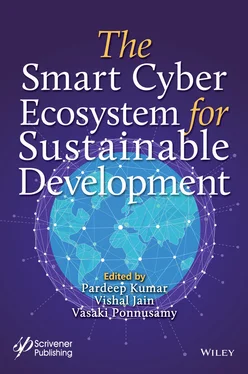2.7.1 Cellular Networks
2.7.1.1 Energy Saving
With the steady increase in the number of users of wireless networks and the need to deploy large number of base stations, and since base stations consume large energy; operating the network with minimum energy is a challenge. One way to reduce energy consumption is the idea of turning off some base stations if users can be served from others, while maintaining a reasonable QoS level. Learning the operation of the network over time helps in improving decisions about which base stations might be switched off.
An SDN-based ML system for energy saving is proposed in [15]. Performance of neural networks and SVM algorithms is compared. The network trains itself using data collected from base stations and recommends the operator time periods during which some base stations are predicted to handle very low traffic and therefore can be switched off.
The authors of [16] propose a Q learning method for base station on-off switching. The switching of base stations is defined as the actions, while the traffic load is defined as the state. The overall objective is to minimize energy consumption. Policy values are used by the controller to decide on switching. After performing a switch operation, the system state is changed and the energy cost of the former state is computed. If the energy cost of the newly executed action is smaller than energy costs with other actions, then the controller updates the policy value in order to increase the probability of selecting this action. With time, the optimal switching mechanism is obtained.
2.7.1.2 Channel Access and Assignment
The effective use of wireless channels has become an urgent necessity, as many heterogeneous systems operate in the same frequency band. Thus, coexistence and organized access of the shared frequency chunks by systems are necessary. Consequently, any design of the wireless channel sharing mechanism should be based on a prediction of the behavior of networks users.
In [17], the authors propose deep reinforcement ML-based MAC protocol for the coexistence of multiple heterogeneous networks. The method allows time-sharing access of the spectrum, by a series of observations and actions. The MAC protocol does not have to know the MAC mechanism of other networks and tries to maximize the throughput of all coexisting networks. The authors of [18] employ reinforcement learning for managing cell outage and compensation. The system state is constituted by the allocation of users to the resources of cells and the channel. Actions are related to the power control, while the rewards are quantified in terms of SINR improvement. The authors show that such ML-based approach provides improved performance.
In [19] and [20], the authors use clustering algorithms to group users that share common interests to reduce interference and collisions. The authors show that such clustering improves the access opportunities for wireless users. A cluster header (CH) is selected to collect data from all devices. It sends the data to base stations which schedule the transmission.
Channel assignment is a well-known challenging issue in wireless networks, especially with systems of limited channels. Such systems highly suffer from interference, and the optimal selection of channels becomes important. Channel assignment problems are normally formulated as convex optimization problems, where algorithms needed to solve such problems are computationally complex. In a dynamic environment of wireless networks, understanding the behavior of network users and learning from previous data is expected to be a good approach for improving channel assignment mechanisms.
The paper of [21] uses ML approach to tackle the channel assignment problem and developed a computationally efficient solution for this problem. The objective is to maximize the total data rate experienced by all users assuming limited resources and large number of network users. The convex optimization problem is converted to a regression problem. Ensemble learning is utilized to combine different machine learning models and improve the prediction performance.
2.7.1.3 User Association and Load Balancing
User association and load balancing is a challenge that has been attracting researchers of wireless networks. The question is how to optimally assign users to base stations and distribute the load in a balanced way among network base stations. The aim is to achieve high QoS to all users and at the same time efficiently utilize network resources.
The authors of [22] investigated the use of deep learning to perform user-cell association to maximize the total data rate in massive multiple input multiple output (MIMO) networks. The authors show how a deep neural network; that gets the geographical positions of users as input; can be trained to approach optimal association rule with low computational complexity. Association rule is updated in real-time considering mobility pattern of network users.
A method for cell outage detection was proposed in [23] using neural networks and unsupervised learning. The main feature of the method is the training of the network which can be performed in advance even when the cell outage data is not available. Moreover, the developed method could work in time-varying wireless environments. The machine learns from measurement reports of signal power which are collected by mobile devices.
The research work in [24] proposes a distributed, user-centric ML-based association scheme. The algorithm is based on fuzzy Q-learning, where each cell tries to maximize its throughput under infrastructure capacity and QoE constraints. With this scheme, cells broadcast data values to guide users to associate with best cells. The values reflect the possibility of a cell to satisfy a throughput performance level. Each cell tries to learn the optimal values through iterative interaction with the environment. In [25], the authors used realistic mobile network data and investigated methods for failure prediction. They compared the performance of the SVM and several neural networks.
2.7.1.4 Traffic Engineering
The process of analyzing traffic in networks is normally performed through examining messages and extracting information from them. This helps in developing effective assessment strategy of how network users behave and identifying their goals from using networks, as well as knowing the data paths and communication patterns. All of this can be used to provide information for network management algorithms and to optimize the use of network resources.
Traffic engineering is related to two processes: Prediction and Classification. Traffic prediction is a process for anticipating the traffic volume based on previously observed traffic volume; while traffic classification is a process of identifying the type of traffic. The process of traffic classification is based on collecting large number of traffic flows and analyzing those using ML techniques. Classifying traffic would help in improving security, QoS, capacity planning, and service differentiation. Classes could be: HTTP, FTP, WWW, DNS, P2P, Skype, and YouTube. Classification can be based on one or more traffic parameters, such as port number, packet payload, host behavior, or flow features [26].
ML is considered as an efficient tool in [27] for applying traffic engineering concepts. The authors use naïve Bayes classification, which uses supervised learning to construct a learning model for traffic analysis and classification. They developed a new weight-based kernel bandwidth selection algorithm to improve the constructed kernel probability density and ML model. The authors of [28] developed and SDN-based intelligent streaming architecture which exploits the power of time series forecasting for identifying users’ data rate levels in wireless networks, trying to improve the QoS of delivering video traffic. The SDN architecture is comprised of Data Plane (Switching devices), QoE management plane (management, bandwidth estimator, monitor, policy enforcer, and bandwidth forecaster), and CP aims to support the delivery of video services and to provide the QoE-based resource allocation per user.
Читать дальше












